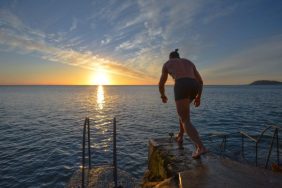A last minute plea for an amateur athlete to complete the swim leg of a half-Ironman relay seemed like an opportunity too good to pass up. After all, I love swimming and I’m competitive. Two kilometers in a lake 2 km in a lake near Salzburg seemed like a do-able, yet challenging endeavor. But where to train? Swimming 100 lengths of my gym’s indoor, 20m pool, continuously without stopping has improved my stamina, but it’s not exactly ideal conditions. With the end of August, and race date approaching, I sought a warm, sunny retreat to both work, and train with a low hassle factor. I think I found the perfect place.
Two hours north of Barcelona sits the rugged Costa Brava, a place vastly different from southern Spain, which suffers from over-population of Easyjet passengers in search of O’Malley’s pub. That old stereotype of north vs. south rings true here, with a very quietly sophisticated, low key look and feel about the small, seaside towns near France’s basque country.
“We have very, very strict zoning and building laws here,” Mark Haaksma, whose family owns Triton Diving tells me as he points out the absence of high rise buildings. Mark has taken me, along with some Dutch and Spanish tourists out for a snorkel not far from the shoreline at Llafranc, one of a string of beach towns connected by coastal walks. There are no wide, open beaches; this is a place of endless small coves. Up in the carved-out, stone hills, we catch a glimpse of homes belonging to the jet set, including the man who invented Velcro. None of the structures are lavish and the very fact that they chose this well-preserved fishing village, without fancy restaurants and expensive shops, tells me everything I need to know and love about this place.
Related: Wearable Fitness Tech Can Still Look Good
The traditional feel isn’t the only thing local government works hard to protect. In the neighboring villages of Calella and Llafranc, there’s a coastal path, but more importantly, a swim lane in the Mediterranean. A ritual early morning swim happens daily; with locals and visitors swimming the 1k distance from one town the other, and then back again, guided by yellow buoys purposely placed to keep them safe and away from boats. It’s exactly what I’d hoped for. It’s true; freshwater and saltwater have their differences, but working in a plus and minus for the buoyancy, but also the denseness of the sea, levels it.
Although I’m here mainly to swim; the area is a playground for triathletes. Racing bikes handle the combination of flat, paved roads and hills with ease and runners hit the streets early and late to beat the heat. Palafrugell, a small inland city which governs Calella and Llafranc, is just 4 km away — a perfect run, followed by a swim. A town centre which pulses from 8am until 1pm with a local market and coffee bars, and then again from 5pm until after dark with live music, open-air restaurants, ice cream shops and boutiques makes Palafrugell a good base.
WHERE: Costa Brava – there are a number of beautiful areas. I visited Palafrugell, Calella and Llfranc.
GETTING THERE: Fly to Barcelona and either rent a car or take the Costa Brava bus which has regular service in season. Book ahead for weekend travel.
GETTING AROUND: Local car rentals aren’t cheap, but stay longer than 4 days and you’ll want one. There are two bus lines: the normal one, which worked fine and the tourist bus which hits all the beaches.
STAY: I rented a simple, but perfect air-conditioned apartment in Palafrugell which came with a large terrace, sun beds, and a gas barbecue, from Mark and his wife Mim at Triton Diving. Calella and Llafranc would be optimal without a car.
DO: Interval and regular long distance swimming is a breeze here, as is cycling and running with a good mix of flats and hills.





